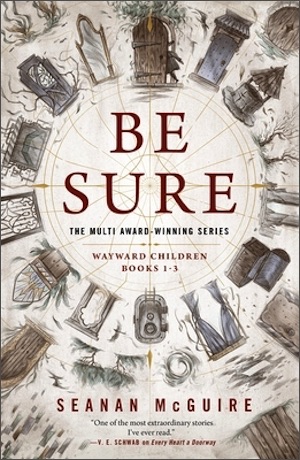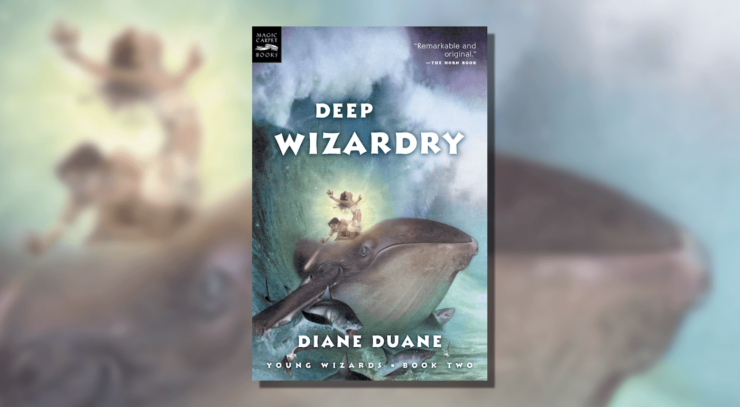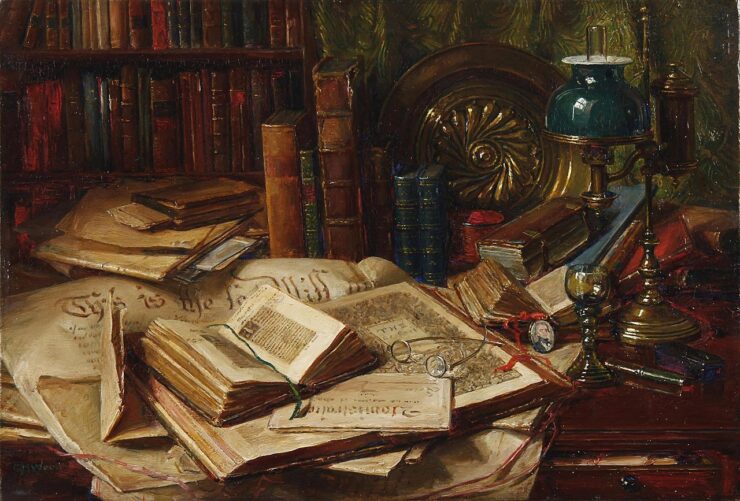Shifter romances and their urban-fantasy cousins pretty well stick to land animals (and birds, and mythical creatures of similar habitat). Sea creatures are much less common. I’ll be getting to selkies shortly, but in the meantime, I can’t pass up the opportunity to reread a classic: Diane Duane’s Deep Wizardry.
This is the second of her Young Wizards series, and was first published in 1985. Duane has updated the series in recent years, with new editions, but this volume is still the same literal deep dive it’s been for nearly forty years. It owes a perceptible debt to Madeleine L’Engle’s A Wrinkle in Time and its sequels. Star Wars was still new; Yoda pajamas were a geek-tween fashion statement. Personal computers had just barely started to show up in middle-class houses, and the universality of cell phones was still a long way off.
It’s almost a historical novel now, with its distillation of Long Island and New York City in the mid-Eighties. The Twin Towers are still standing, and still new. Maps are on paper and research is a thing you do in libraries, with paper books and card catalogues. Kids are free-range—they can go out all day, but they’d better get back by sundown or parents will send out the troops.
Young Wizards Nita and Kit have saved the universe once. Now they have to do it again, because that’s what wizards are for. Supposedly they’re on vacation—Nita’s parents have rented a cottage on Long Island Sound, and invited Nita’s friend Kit to join them. Mom and Dad don’t know that Nita and Kit are wizards, though Nita’s way-too-bright kid sister Dairine, she of the Yoda pajamas, has figured it out.
The young wizards’ vacation ends abruptly when they find an injured whale on the beach. Nita can communicate with animals—and the whale is a good deal more than that. She’s a wizard, too, and the world is in great danger again, and needs Nita and Kit to help save it.
This is a strongly dualistic universe. Wizards exist in order to protect against entropy. Entropy, and death, are the work of the Lone Power, which works on its own and through endless incarnations of itself and its slaves and servants. Every time it’s defeated, it pops up somewhere else, and wizards have to defeat it again. It never gives up, and it almost never surrenders.
This time, the threat comes from the deep sea off Long Island, far down below the surface. The wizards of the sea, who are various species of cetaceans, from the great whales to the dolphins, have to renew an ancient ritual. If they fail, the sea will erupt, and most of that part of the world will be destroyed.
The Lone Power’s servants have already destroyed the senior whale-wizard who should have been leading the Song of the Twelve. His successor is very young and inexperienced, and she’s the whale whom the human wizards find on the beach.
Nita and Kit are called to help with the Song. In order to do that, they have to shapeshift into whales. Nita does it through basically willpower, transforming into a humpback. Kit resorts to a more mechanical magic: he uses a whalesark, a cloak or shirt made from the neural net of a sperm whale. While Nita can think herself into whale shape, Kit has to put the sark on in order to shift.
Nita’s transformation can be dangerous if she forgets how to shift, but it’s based on her own mind and will, and she can control it relatively easily. Kit’s, by contrast, is imposed on him from without. The sark retains some of the personality of the whale who died to make it. He has to be extremely careful not to lose himself altogether. This is especially true when he’s under stress, and when he’s engaging in battle. Sperm whales are warriors. They live to fight against the monsters of the deep—many of whom serve the Lone Power.
Nita might not be in as much danger from her transformation, but her role in the Song more than makes up for it. She agrees to sing the role of the Silent Lord—but she forgets one important piece of advice she receives before she takes on the task. Always read the fine print. By the time she realizes what she’s actually agreed to do, she’s so deep into it that there’s no way she can really get out.
These books may present as upper-middle-grade fantasy adventure with early-teen protagonists, but light and fluffy, “kid-safe” books, they are not. They are beautifully written, deeply thought out, and they do not flinch. At all. Deep Wizardry hits me straight in the gut, and I haven’t been a tween for rather a while.
There’s plenty of kid-detail, to be sure. Dairine is the ultimate bratty kid sister. Mom and Dad are too well aware that both she and Kit are on the threshold of adolescence, i.e., puberty. They try to enforce deadlines and curfews, which cause major problems for the young wizards’ commitment to the ritual—and if they don’t participate, the death toll will be in the millions. It might anyway, if they fail, but if they let themselves be constrained by normal kid-constraints, there won’t be any ritual at all. And that will be end of Greater New York and a good part of the eastern seaboard.
In that respect this is a coming of age story. Kids grow up and assert their independence. They learn empathy by becoming members of a different species. Duane has done a lot of studying and a lot of thinking about how whales perceive the world: how their senses work, how they communicate, what it’s like to be cetacean, an air-breathing mammal who lives entirely in and on the sea.
Buy the Book


Be Sure
The heart of the book is transformation. Growing up, yes, in all its shapes and forms. Sacrifice—what it means, how it works and doesn’t work. Death, because that’s what happens to every living thing, however soon or late. And love. That, always.
As lovely as the cetacean characters are, the most powerful character of all is also the most terrifying. His name is a succession of grindings and gnashings. Nita calls him Ed, both because it’s easier to remember, and because she needs to make him just a little bit easier to bear. He’s the one participant in the Song who has no magic, and who is not a cetacean. Ed is the Master Shark, the Pale Slayer, ancient and possibly immortal, a gigantic white shark who is the personification of death.
The Lone Power may have created death, but Ed is no servant to him or to any other power in the world. Ed simply and purely is. He has one purpose: he puts an end to distress. When blood stains the water, he comes. He does what’s necessary.
No one and nothing has ever loved him, and that’s an essential part of his role in the Song. Of all the creatures Nita meets under the sea, he’s the most fearsome. And yet, in the end, she learns a great lesson from him, about death, and about love, and about the ultimate sacrifice.
This is not an easy book. It’s wonderful and powerful and terrible. It will break your heart. And I keep coming back to it, because of all the shapeshifters I’ve read and seen on screen, Duane’s whales are the most deeply felt and the most thoroughly thought through. Duane doesn’t just get it right. She’s gets it, in the fullest sense of the phrase.
Judith Tarr is a lifelong horse person. She supports her habit by writing works of fantasy and science fiction as well as historical novels, many of which have been published as ebooks. She’s written a primer for writers who want to write about horses: Writing Horses: The Fine Art of Getting It Right. She lives near Tucson, Arizona with a herd of Lipizzans, a clowder of cats, and a blue-eyed dog.














